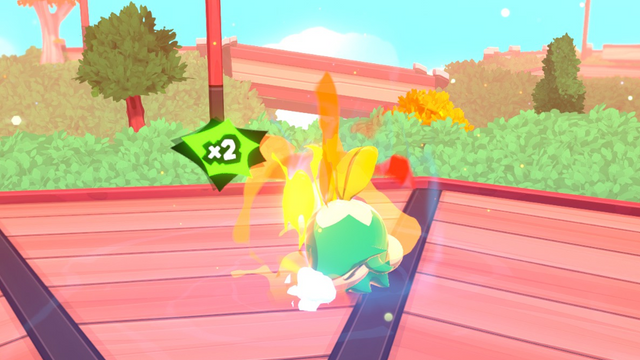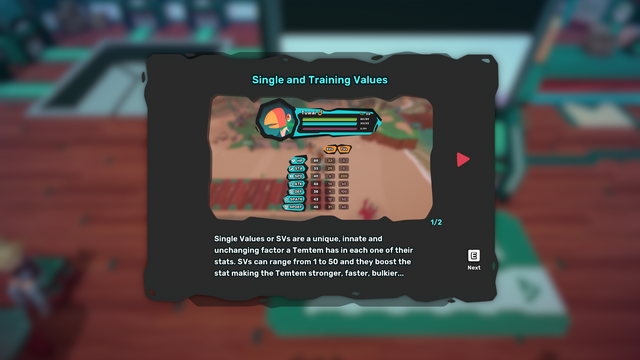There’s a lot going on under the hood of Temtem. Not only are there all those types you’re unfamiliar with, physical & special techniques, synergy, and more, but also… what the heck are Base Stats, SVs, and TVs? How do these stats affect your Temtem? Can you raise and lower them? Is there an optimal way to do so? Here’s everything you need to know about Base Stats, SVs, and TVs in Temtem.
If you’re a hardcore Pokemon fan coming over to Temtem, I can save you some time. Base Stats are about the same between the two, although Temtem has an additional stat — Stamina. Temtem’s SVs and TVs are equivalent to Pokemon’s IVs and EVs, respectively. Unlike Pokemon, though, Temtem always displays these “hidden” stats, and includes some in-game tutorialization on the matter. There are some number differentials as well of course, but that’s the gist of it. Now, for those unfamiliar with these complex systems…
“Stats” are the seven physical traits that determine how Temtem behave in combat. These are: Health Points (HP), Stamina (STA), Speed (SPD), Attack (ATK), Defense (DEF), Special Attack (SPATK), and Special Defense (SPDEF).
This set of seven stats is repeated three times for every single Tem, in three different ways: Base Stats, SVs, and TVs. These three stat spreads combine to form an individual Temtem’s stat totals. Stat totals rule combat calculations, determining things like damage given, damage taken, turn order, and stamina loss.
What are Base Stats in Temtem?
Base Stats are best understood as the innate strengths and weaknesses of a Temtem species. They give a general idea of what that species is naturally good or bad at. For example, Amphatyr is an Electric/Nature Tem that appears similar to a deer or antelope. They’re sleek and agile, with long legs. This species has the highest Base Speed in the entirety of Temtem at a whopping 110. Even without extra training, Amphatyr will outspeed most Tems, because they’re naturally very fast.
What are SVs in Temtem?
SVs stands for “Single Values.” They’re a randomized set of stats unique to an individual Temtem — hence the “single” in its name. SVs range from 1-50. Two Temtem of the same species will almost certainly have different SVs. Let’s say you’re facing two untamed Pigepics. You have your Tuwai use Shrill Voice, a special technique that hits both Pigepics with the same strength at the same time. The Pigepic on the left takes less damage than the one on the right. From this, you can determine that the Pigepic on the left has higher Special Defense SVs than the Pigepic on the right.
When you breed Temtem together, they have a chance to inherit SVs from their parents. Through the use of Breeding Gear, you can guarantee this, and create Temtem with perfect SVs. However, this is quite complicated and sucks up a lot of time and resources, so I wouldn’t recommend it for a regular playthrough.
One fun fact about SVs is that Luma Temtem — Temtem’s equivalent to Pokemon’s shinies — are guaranteed to have at least three perfect SVs. Additionally, their remaining stats (with the exception of Speed) are given an increased floor of 20. Three perfect stats and 3-4 improved stats is nothing to sneeze at, and a great quality-of-life feature for the most sought-after Tems.

What are TVs in Temtem?
TVs stands for “Training Values.” They’re a non-random, controllable set of stats gained by defeating or taming Temtem. Because they can only be attained through “training,” newly caught or hatched Temtem have no TVs at all. An individual Temtem can have a maximum of 1,000 TVs total, with no more than 500 in a single stat.
The TVs gained through training aren’t random, either. Temtem yield 1-4 points across 1-2 specific stats after being defeated or tamed. Fomu always yields 2 Special Defense TVs, while Zenoreth always gives 2 HP and 2 Defense TVs. You can view any species’ TV yields in the Tempedia at any time, as long as you’ve beaten or captured them before.

When allocated properly, TVs can have a huge effect on a Temtem’s ability in combat. There’s an advanced form of Temtem training that involves maximizing TV efficiency, called TV training. It can get very complex very quickly, so I’ve written a beginner’s guide to help you through the process.


